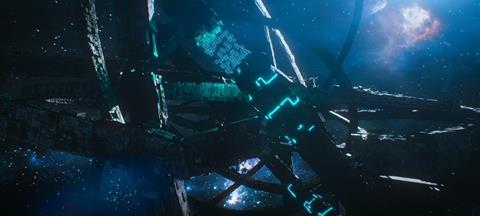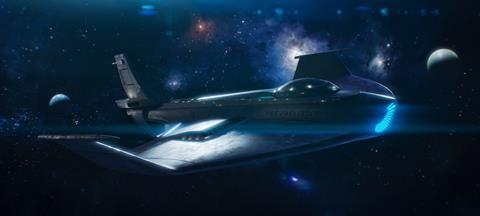Union produced over 200 VFX shots for seventh series finale

Union has revealed the work that went into produced over 200 VFX shots for the finale of Black Mirror’s seventh series.
The episode, USS Callister: Into Infinity, is a sequel to series four’s opener, with Captain Nanette Cole and her remaining crew struggling to survive within the Infinity game while grappling with the consequences of their digital existence on their real-world counterparts.
More than 90 artists across Union’s London and Montreal offices worked on the episode, led by DFX supervisors David Schneider in London and Iain Read in Montréal, supported by Tallulah Baker producing across both sites. They worked with VFX supervisor James MacLachlan and VFX producer Josie Henwood, with the shots encompassing hero spaceships and teleportation to respawning effects, expansive galactic environments and a climactic showdown around the colossal Heart of Infinity.
Union was given access to the original USS Callister model and brought it up to date for its USD-based CG pipeline, and a key scene was the final climactic battle. Schneider explains, “We took the designs of the fighter jets, modelled them and accentuated them with coloured emissive lights reflecting the costume design of each character. This really helped the audience follow the action and added that retro game feel.

“The action constantly evolved through collaboration with Toby, Charlie and the VFX production team. Union was supplied with previs mapping out the action beats which was ingested into our pipeline once we entered full production. We were then able to iterate on the animation until we achieved a clear, exciting action sequence true to the Black Mirror world.”
The largest CG build of the episode was the Heart Of Infinity, the centre of the digital world. The concept was created by director Toby Haynes, writer Charlie Brooker and production designer Miranda Jones, creating a brief of large concentric rings rotating around one another in an ominous fashion. Union modelled and animated the Heart of Infinity, presenting various iterations before settling on enormous concentric rings constructed from computer parts, passing around one another at high speed, chopping like guillotines.
Visualising teleportation was another key aspect of the project, with distinct design of the characters dissolving into digital cubes. Schneider says, “We came up with the idea of how, in games, you have elements that progress from low detail to high detail as more data is loaded. We used this as the concept behind the teleporting. The first thing you see is a low-resolution, blocky structure, roughly the shape of the character. It then refines through several levels, resolving into the exact scan of the character’s body. It was a lot of fun to develop, and you really get the feeling of being in a video game. We carried that concept through to the design of what happens when somebody gets killed in the game – players explode into a shower of digital cubes.”

To create the show’s expansive galactic environments, the shows production team drew on the work of artist Mark Kolobaev, whose concepts were adapted into animated, moving images.
The production also used a large LED wall for the Callister Bridge’s viewport, giving the cast real images to interact with and enabling natural lighting from the on-screen visuals. This approach created realistic reflections on the chrome surfaces of the set, reducing reliance on green screens and cutting down on green spill.
Union delivered high-resolution sequences of space environments, planets, hyperspace and laser fire effects for live playback on the LED wall, with green and grey screens available at the push of a button.








No comments yet